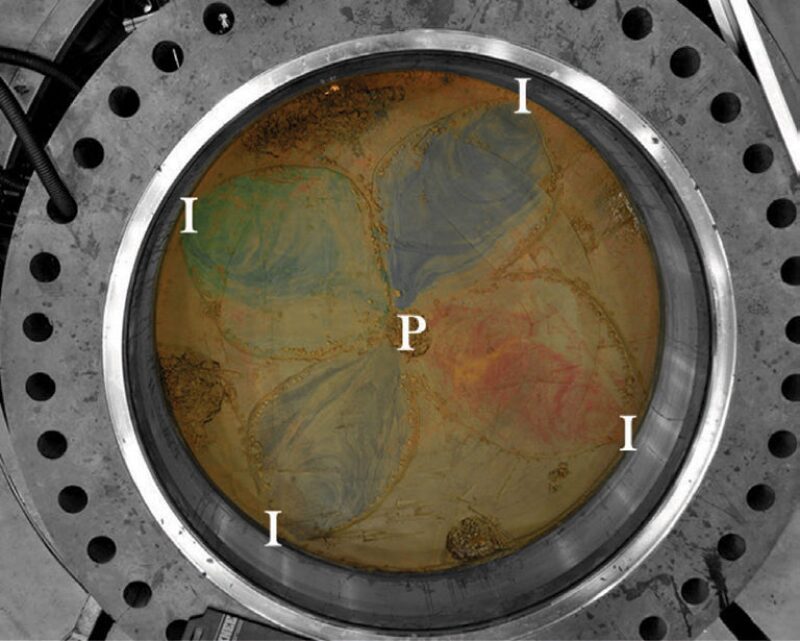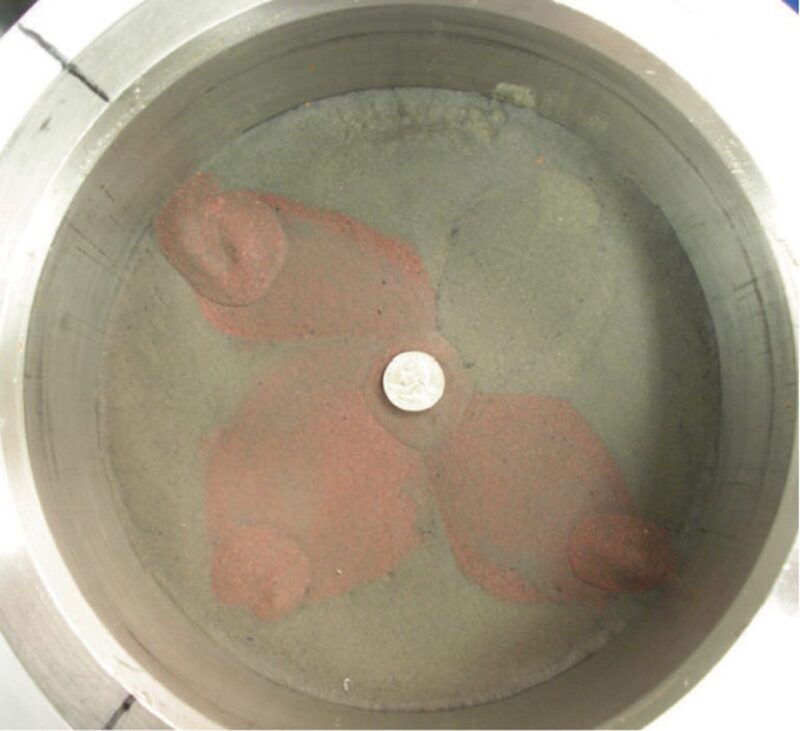This paper presents a concept for recovery in Canadian oil sands that uses water injection to condition a reservoir interval sufficiently to relieve the overburden stress on the oil sand and increase its porosity and permeability. The ability of the process to work in thinner and more geologically complex reservoirs compared with other in-situ processes, and with lower CO2 and surface footprints than those seen in thermal and mining processes, could make this an attractive alternative recovery process for shallow- to intermediate-depth in-situ bitumen resources.
Introduction
Canadian oil-sands recovery is challenged by the high and ultrahigh viscosity of the heavy oil and bitumen trapped within the generally unconsolidated sand matrix of these reservoirs. Steam processes have dominated the in-situ recovery of this resource, but steam/solvent and solvent-only processes are currently being field tested. Steam processes, especially low-pressure processes such as steam-assisted gravity drainage (SAGD), are challenged by both a high degree of geologic heterogeneity and thin pay zones.
In-Situ Mining of Oil Sands
The very shallow (less than 70-m) depth of a large portion of the oil-sand deposits of Canada has made their surface mining a technically feasible and economical method of recovering the bitumen from the shallowest portion of the oil sands. The success of surface mining for bitumen has led others to propose and test in-situ bitumen mining processes. Hydraulic mining of the oil sands from a borehole has a rich patent literature but few conclusive field tests. The basic concept is that a high-pressure, downhole water jet could disrupt the unconsolidated sand matrix around the wellbore such that a bitumen/water/sand slurry could then be produced to the surface for bitumen extraction with surface-mining techniques. The process is technically challenged by the limited volume of hydrocarbons that can be recovered from any given wellbore and the limited “cavern” size that can be supported without roof collapse in these unconsolidated sand/shale geologic environments.
Slurrified Heavy-Oil-Reservoir Extraction (SHORE)
The potential benefits from an in-situ heavy-oil-recovery process that (1) does not require hydrocarbons (i.e., is neither steam- nor solvent-based), (2) is amenable to thinner or more-geologically-heterogeneous reservoirs, and (3) gets around many of the challenges of current surface and in-situ mining processes has led ExxonMobil to develop the SHORE process. The SHORE process capitalizes on the shallow and unconsolidated nature of the majority of the Canadian oil sands. Shallow sands tend to have higher horizontal than vertical stresses, especially in Alberta, where previous glacial loading and tectonic stresses have led to the ability to create deep horizontal hydraulic fractures, generally down to a depth of 350 to 450 m.
The injection of cold water into a set of wells would allow the creation of horizontal hydraulic fractures, leading to the pressurization of individual bitumen-bearing sands (Fig. 1). Field data from the cyclic-steam-stimulation process and from laboratory data show that pressuring these sands to nearly the overburden pressure leads to significant dilation, permeability increase, and mechanical failure of the sands. Turning a number of wells in a standard five- or seven-spot pattern into producing wells while keeping the rest as water-injection wells would allow the development of sufficient pressure gradients between injectors and producers to allow for the production of a sand/water/bitumen slurry up the wellbore. This slurry production would create a dilated region around the producing well that propagates back toward the injector. The evolution of effective stresses on, and pressure gradients within, the reservoir sand during this startup/transition period would lead to the creation of a large lobe (with a width of 40 to 60% of injection/production-well spacing) of slow-moving sand.

The reservoir ore produced as slurry can be processed similarly to surface-mined ore, separating the bitumen from the solids and water and then treating the tailings so that the solid fraction can be reinjected into the reservoir. It is after the startup/transition period that the reinjection of the solid-tailings slurry would begin. The reinjection serves as a means for disposal of the slurry back into the subsurface, providing a support mechanism for the overburden “roof” and an aid to the sand-displacement mechanism dragging the sand from the injector to the producing well. The process continues until the breakthrough of the cleaned, reinjected sand into the producer wells.
For a discussion of the physics of the SHORE process, please see the complete paper.
Experimental Validation
The SHORE process was first validated on the 25-cm scale in a Lucite pressure vessel on loose sands with little to no effective stress. This simulated the process from a post-conditioning state. Large, symmetric lobes developed between the injector and producer, and key physics of the process was validated.
A steel pressure vessel was then constructed to test the conditioning through startup to steady state under stress conditions likely in real reservoirs. Lobes of reinjected sand were seen with high sweep of the in-situ sand in the 20-cm-diameter, 2-cm-thick sandpack. Although the experiment validated key physics, the process of determining how the method would scale up and the effect upon it of realistic heterogeneity, as well as collecting a dense-enough array of data to validate numerical models of the process, suggested that another scale of experiments would be appropriate.
A large-scale experimental apparatus was constructed and commissioned to test the SHORE process in 2-m-diameter, 5- to 20-cm-thick sandpacks under full reservoir conditions [dubbed LARGE (large-scale apparatus for reservoir and geomechanics experiments)]. More than 450 sensors above, below, and within the sandpack have provided detailed insight into the feasibility and operation of this process. Stress, pressure, acoustic, flow, temperature, and resistivity sensors allow us to assess not only pressure gradients and effective stresses throughout the sandpack during the process, but also the real-time imaging (through conductivity contrasts) of the advancement, size, and shape of the lobes of reinjected sand.
Because the bitumen in the SHORE process does not move relative to the sand, the process is controlled by the mobility of fluid movement through the sandpack. As such, all but a couple of small-scale tests were conducted with a single-phase fluid simulating the mobility of water in a bitumen-saturated sandpack (thus accurately simulating the fluid-and-sand-flow physics). However, the scale of the LARGE apparatus has afforded the opportunity to test the process with a heavy-oil-saturated sandpack.
It is only in the LARGE vessel that the density of pressure and stress measurements has allowed for full understanding of the complexity of the evolution of stresses and pressures in the reservoir interval during the startup/transition period that leads to steady-state sand flow. The LARGE vessel has also afforded the opportunity to test the process with a simulated reservoir overburden. The polypropylene spacer that separates the sandpack from the hydraulic fluid that applies stress to the sandpack has been designed to mimic the deformation that a real reservoir overburden would undergo, and, more importantly, to show how that deformation would affect the distribution and evolution of stresses on the sandpack. The similarity in sweep patterns (compare Fig. 2 and Fig. 3) and laboratory results between the 20- and 200-cm tests gives us confidence that the process can be scaled to realistic well spacings (100 to 150 m).


Numerical Modeling
The movement of a large lobe of reservoir sand and the injection and production of large quantities of reservoir sand, all under full geomechanical and reservoir conditions with fluid flow through the moving sand, present unique challenges to numerical modeling generally not previously considered for petroleum-reservoir modeling. We have developed a proprietary, full-physics numerical model of massive sand flow under full reservoir and geomechanical conditions, leveraging a finite-element geomechanics/computational-mechanics code that was particularly effective in modeling large displacements during landslides and metal forming. The most-novel aspects of this code are casting it within an adaptive Lagrangian-Eulerian framework and adaptive remeshing to allow for large-scale displacements and Eulerian boundary conditions at both the injectors and the producers to allow for the massive and continuous sand injection and production. Modeling this process faced further challenges in that most of the process occurs under very small effective stresses, and the stability and accuracy of the material constitutive models at low effective stresses require careful model calibration. However, validation and calibration of the model with geomechanical material testing and with results from the LARGE experiments have allowed us to use this model to understand the process, determine its likely technical feasibility, and extrapolate our understanding to how the process is likely to work on a commercial scale in the field.
Impact of Geologic Heterogeneity
There is a significant decoupling between the effectiveness of the SHORE process and geologic heterogeneity as compared with other flow-through-porous-media-based recovery methods. Reservoir zones with significant interbedded mudstones face recovery challenges with steam- and solvent-based processes because the mudstones serve as baffles, if not barriers, to steam-chamber growth, bitumen flow to the producer, or solvent contact with a large reservoir volume. Although a significant fraction of mudstones can slow down the conditioning process, the conditioning process itself serves to break up mudstone barriers and create pathways through the mudstones.
In addition, modeling shows that once the reservoir is conditioned, a fair number of interbedded mudstones will flow with the sand lenses toward the producer well and be produced up the well with the bitumen sands. Modeling and laboratory work also show that there are large shearing forces within the moving sand bed as it converges on a production well. We observe significant shearing of both sand and mudstone bodies into pieces small enough to be produced up the wellbore.
More work is needed to fully assess the impact of heterogeneity, but the physics of the process, and modeling and laboratory tests to date, strongly suggests that reservoirs not amenable to a process such as SAGD, or those whose recovery may be significantly degraded because of their heterogeneity, may have much more success with a process such as SHORE.
Benefits of the SHORE Process
The work to date has validated, from a numerical and laboratory perspective, that this process has significant technical potential to recover a wider range of bitumen resources than other current in-situ technologies. The work has shown that the process is likely to operate with a significantly smaller CO2 footprint than thermal-recovery processes, with complete disposal of tailings back into the subsurface, and has the potential for near-zero freshwater use. Recovery factors are likely to be in excess of 50%, with bitumen-production rates per well in the range of 1,000 to 2,000 B/D. Well spacings of 6 to 8 acres are similar to those of other in-situ processes such that the high well-production rates translate to draining of any given reservoir volume in 2–3 years.
This article, written by JPT Technology Editor Chris Carpenter, contains highlights of paper SPE 165498, “Slurrified Heavy-Oil-Reservoir Extraction (SHORE): A Nonthermal, In-Situ Recovery Method,” by David P. Yale and Jianlin Wang, ExxonMobil Upstream Research; Steven W. Meier, Eric Herbolzheimer, and Arnold P. Kushnick, ExxonMobil Research and Engineering; Neal L. Adair and Sergio A. Leonardi, ExxonMobil Upstream Research; and Richard J. Smith, Imperial Oil Resources, prepared for the 2013 SPE Heavy Oil Conference—Canada, Calgary, 11–13 June. The paper has not been peer reviewed.
